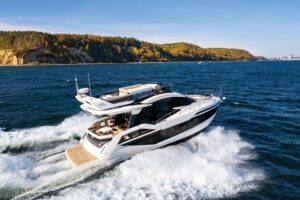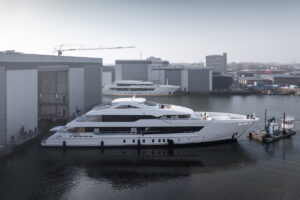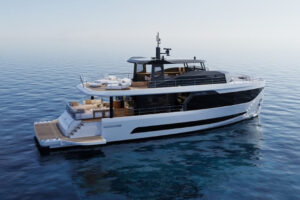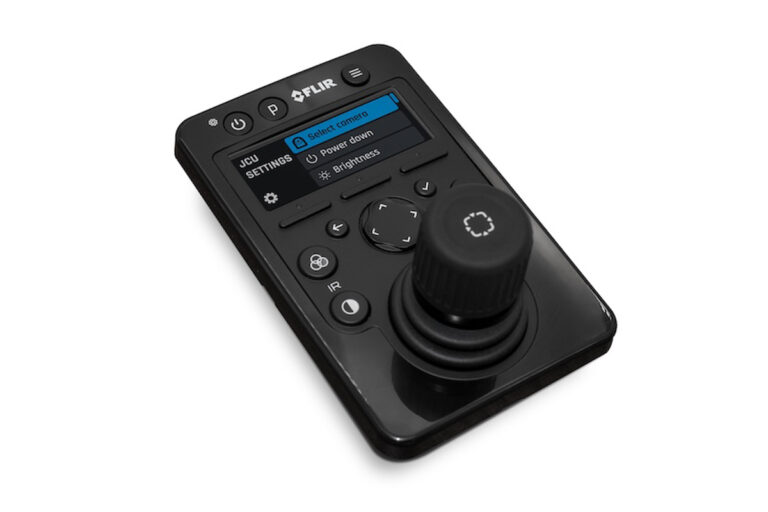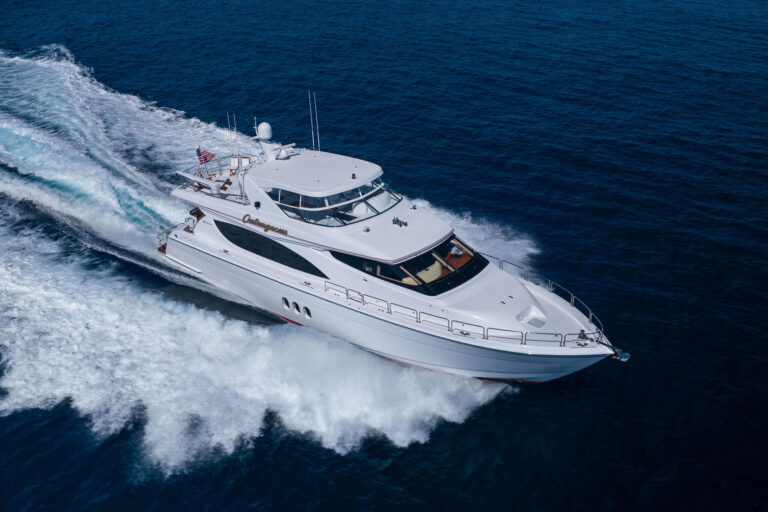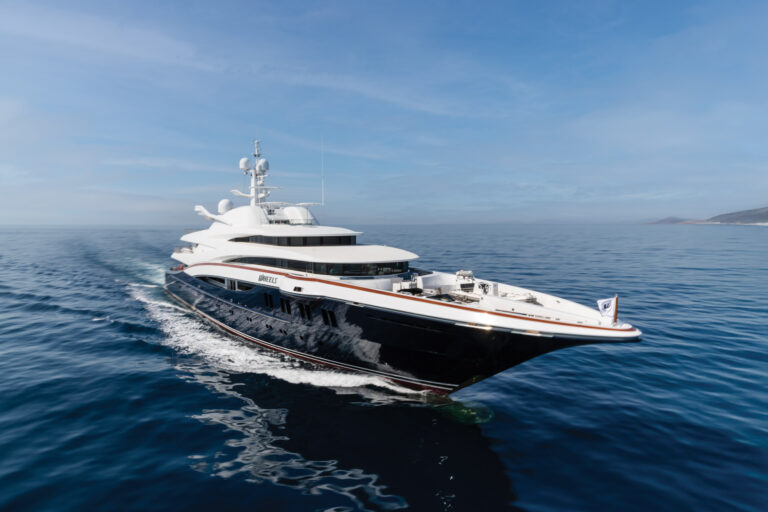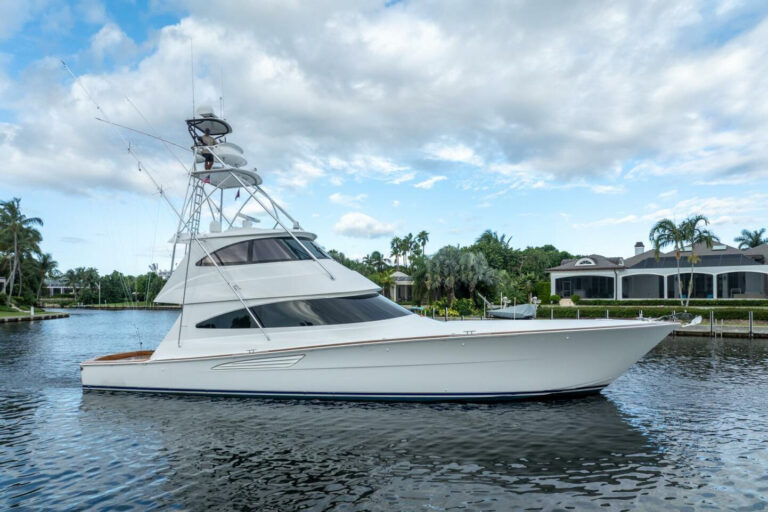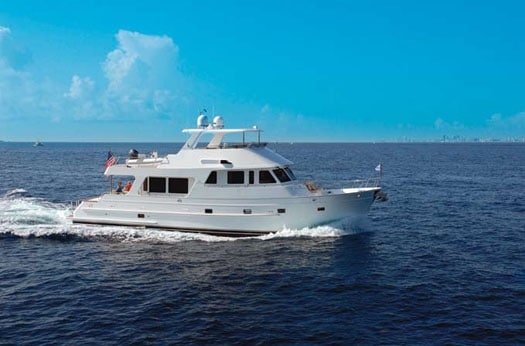
ytgjan09outreef63525.jpg
I was settled in the big leather Stidd helm chair, lulled by the faint sound of the engines and the occasional sploosh of the bow wave as we crested the swells in the Gulf Stream. In the distance, the horizon was a flat blue line that bisected the big pilothouse windows, with a few fluffy cumulus clouds, just for theatrical effect.
The pilothouse doors were open and an occasional puff of the trade winds would find its way in, bringing the scent of sunwarmed teak and fresh varnish. We were cruising at a steady 11 knots, burning about a gallon a mile.
It was, in a word, intoxicating.
The words “if only” are difficult ones. If only I’d bought IBM or Apple back then… If only I’d gotten that MBA…If only this were my Outer Reef 63 motoryacht.
Never mind that there were several boffins from the electronics company tinkering with the radar on the bridge. Never mind that this was a boat test, not the first leg of a grand cruise. Never mind, ahem, that this wasn’t my boat. The idea of spreading a chart of the Caribbean on the table next to the helm, laying a plotter down, and drawing that thin penciled line to adventure was so appealing.
And that’s exactly what makes the Outer Reef 63 such an interesting yacht. This is no marina queen doomed to spend her days doing cocktail cruises on the Intracoastal Waterway: This is a yacht intended, from drawing board to completion, to follow those penciled lines.
Yes, I’m aware that a lot of builders slap the words “Expedition” or “Long-Range” in front of the name of their yachts, but that, in many cases, is all they are: just words. The Outer Reef, on the other hand, is certified to meet the design and construction requirements of the European Union Category A, Ocean. That’s as high as the EU ratings go: Category A is for yachts expecting to encounter winds exceeding Beaufort Force 8 and seas exceeding 18 to 20 feet, on long offshore voyages.
The Outer Reef 63 is the stretch version of the 58-footer, with a water-level cockpit adding the five feet. In my opinion, I can’t imagine ordering the shorter version. The cockpit makes boarding easy and safe whether you’re coming from a floating dock or the tender; it allows easy access to swim off; it provides an entrance to the engineroom while underway; and (again, my opinion) it creates a betterlooking yacht.
Steps lead from the cockpit to what becomes a “California deck” under the protection of the overhanging bridge deck above. A pair of settees is separated by a console and, on each side, boarding doors are built into the coaming. This deck could easily be enclosed, and a pair of wing doors close off the side decks for spray or wind protection.
In fact, it becomes patently clear as you look around the Outer Reef 63 that she has been carefully and thoughtfully designed for the cruising couple who will be running the yacht themselves. Another set of boarding gates are forward in the Portuguese bridge, and the side decks are wide enough that you can hustle from bow to stern to handle the lines or fenders without bruising yourself.
The salon can be arranged to suit your needs and our test boat, the first 63, had an L-shaped settee with a fold-out dining table to port, and a pair of leather club chairs opposite. This makes sense since it provides good seating while underway (with great views through the oversized windows), a comfortable table at which six can dine, and allows comfortable viewing of the 42-inch flatscreen Sharp TV on the forward bulkhead. Teak is the interior finish.
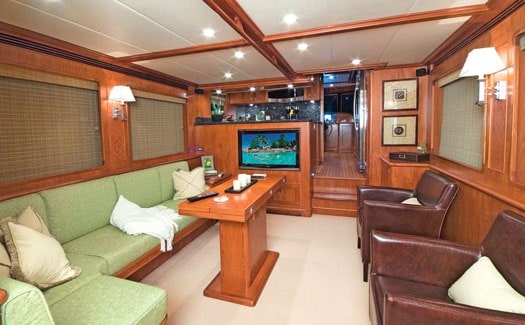
| | |
The galley is two steps up (giant steps they should have three risers) and overlooks the salon, again clearly intended for an owner-cook who wants to talk to guests or spouse. The GE Profile appliances are likely to please the chef, with a five-burner cooktop, microwave/convection oven, two-door fridge and freezer, dishwasher, and trash compactor.
The black granite counter behind the cooktop extends up to create an easily cleaned backsplash, but I have to question the absence of searails around the galley counters. Spill a can of soup and you’ll have a Campbell’s waterfall down the salon TV. There’s also a seemingly big pantry, but the rolling drawers waste a lot of usable space: Either redesign the drawers or opt for solid shelves.
The pilothouse is where I found myself dreaming of seeing islets with palm trees appear on the horizon, and this is a front office that should delight any skipper. With watertight doors on either side to the Portuguese bridge, the teak sole makes sense for all-weather comings and goings. There’s an L-shaped settee aft for guests, and it’s raised enough to give them the same view the skipper has from the helm chair.
The teak dashboard has room for a multitude of electronics and displays and, on our test boat, a pair of Raymarine E120 screens were on the dash above twin Caterpillar digital engine monitors. What I really liked was the console to the right of the helm, which is big enough to handle the binoculars, cruising guides, and all that “stuff you can’t live without” while on watch. To port of the helm is a chart table where you can lay out a full-sized paper chart and fiddle with those penciled lines.
There’s great access to the area underneath the helm console through a door in the nearby stairwell. This will make the electronics installers very happy indeed. My aging eyes and back weren’t quite as fond of the low positioning of the electrical panels, however.
The foyer on the lower deck conceals a full-sized Bosch washer and dryer, which will make doing laundry easy, and there’s a dedicated locker for cleaning supplies, too.
The master stateroom spans the full beam, with a king-sized berth against a padded headboard. A semicircular overhead treatment above the berth has halogen lights, and reading lights are on the bulkhead. There are drawers under the berth and lockers in the forward bulkhead, plus two big hanging lockers, so where to put clothing for a cruise shouldn’t be a problem.
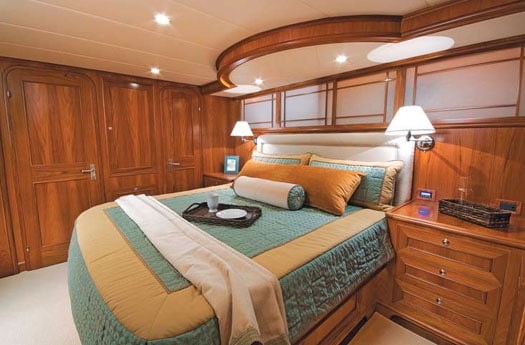
| | |
The master head is to starboard behind a space-saving pocket door, and I found it notable not just for the oversized stall shower with a seat, but for the unusual shower sole of teak “tiles.”
The guest cabin is forward and has a high, tapered berth with steps on each side for easy access. Again, clothing stowage is ample, with a pair of hanging lockers plus drawers under the berth. There is private access to the starboard head which, like the master, has an oversized shower stall with teak-tiled sole.
The third cabin is fitted with upper and lower bunks, a three-drawer nightstand, and a mica-finished hanging locker. This cabin has access to the head just across the passageway.
The bridge is capped by a nicely finished optional fiberglass hardtop that complements the yacht’s lines, rather than looking like an afterthought. This incorporates an electronics arch and bridge lighting, and could be fitted with a soft enclosure for weather protection.
A single Stidd chair is on centerline behind a fiberglass console with, in the case of the test boat, just a single Raymarine screen. As in the pilothouse, there is a big chart area to port and a console under the skipper’s right side. Aft, an L-shaped settee has a triangular Hi-Lo table for lounging or dining. Opposite is an outdoor kitchen with a GE Monogram grill, an undercounter fridge, and a sink.
The boat deck, which extends to the full beam to provide protection for the side decks below, is spacious and the 12-foot Novurania tender left plenty of room on each side, even with the 1,200-pound Brower davit. There’s a hatch and ladder leading to the afterdeck but it’s absolutely vertical and I’d use it as a last option for getting below.
Access to the engineroom couldn’t be better, with a big watertight door leading to the cockpit, and another watertight door (hidden behind a stylish teak door with rounded corners) into the master suite. Standard power is a pair of 503-horsepower Caterpillar C9 diesels. A Northern Lights 16 kW genset sits within a soundshield.
There’s good access to the engines, from which you’re protected by a stainless steel rail. Stabilizers are standard along with the American bow thruster and Maxwell anchor windlass. Other standard niceties include an oil-change pump, 75-foot Glendinning 50-amp Cablemaster, dual 50-amp isolation transformers, and a Trace 2.5 kW inverter for sitting at anchor with ice, but without noise.
The additional five feet of cockpit provides an immense amount of storage that cruisers will certainly put to good use with spares and provisions and dive gear and, well, all the makings of adventure.
Underway, the Outer Reef 63 was predictably mild-mannered and surprisingly quiet. Even at a full speed of about 15 knots, we never exceeded 68 decibels in the pilothouse. With plug-in remotes, the skipper can maneuver from almost anywhere on the yacht, and these add to the short-handed capabilities. At 2000 rpm, she’s sliding along at about 12 knots, which will eat up the miles and still keep the diesels happy for thousands of hours.
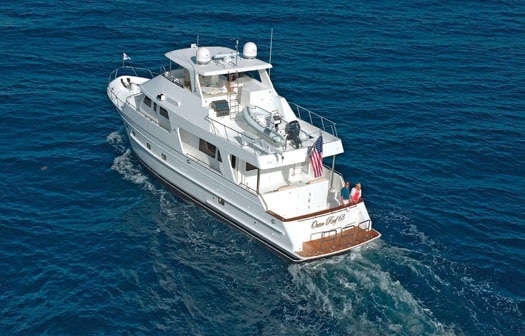
| | |
No one sets out to find Force 8 winds or heavy seas, but anyone who has spent enough time offshore knows that sometimes they’ll find you. And that’s when the design and construction of the Outer Reef 63 will bring you peace of mind.
I had my “if only” moment looking at the far horizon through the windshield of the Outer Reef 63…don’t miss yours.
Outer Reef Yachts, (954) 767-8305; www.outerreefyachts.com

